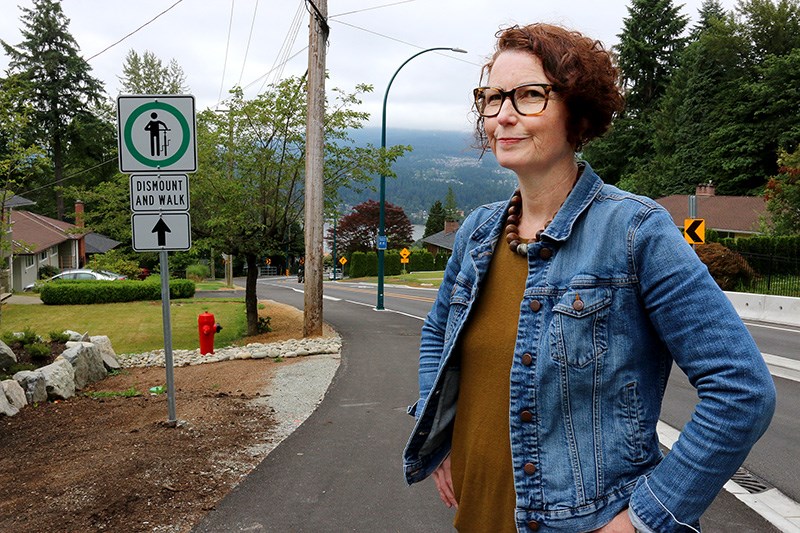Two months after Gatensbury Road re-opened following seven months of construction for safety improvements and the addition of a new multi-use pathway (MUP) on its west side, the city of Port Moody is considering further safety enhancements.
Kim Law, Port Moody’s manager of project delivery services for engineering, said the city will look at a public education campaign to better inform cyclists to dismount and walk their bikes if they want to descend the steep, winding route that connects to Coquitlam, or ride down the northbound side of the road. He said the city will also periodically monitor how the path is being used by cyclists and pedestrians to determine other ways to discourage cyclists from riding it downhill.
Lori Holdenried, who lives on Gatensbury, said the completion of the road’s $4.627-million rebuild has been a blessing to her neighbourhood. She said neighbours are meeting each other for the first time outside lobbying efforts at Port Moody city hall because the new MUP allows them to stroll up and down the hill to one another’s home.
“It’s built a community,” she said.
But Holdenried said several of her neighbours, along with herself and her daughter, have already had close brushes with cyclists speeding down the smooth path, even though they’re not supposed to.
She said signs posted at the top of the MUP and halfway down advising cyclists to dismount when descending are confusing because they’re quickly followed by another sign indicating the MUP is to be shared by pedestrians and cyclists.
Law said right from the design stage, the MUP was intended for pedestrians and cyclists heading up the steep climb, as they’re moving at about the same speed. The northbound lane of the roadway, which is a designated cycling route, should be used by cyclists heading downhill, he said.
Holdenried said she suspects some of the confusion may be caused by the abrupt end of the project when it hits the Coquitlam border, midway through the last slope up towards Bartlett Avenue.
Dragana Mitic, Coquitlam’s manager of transportation, said that city didn’t identify Gatensbury as one of its priorities for a MUP in its strategic transportation plan even though the street is a designated bike route.
She said Coquitlam staff did liaise with Port Moody as plans for the MUP were developed, and an asphalt sidewalk was extended from the border between the two communities to Bartlett Avenue that “formalized the existing pathway.” But no additional signage indicating cyclists need to veer onto the road at that point, nor that northbound cyclists must stay on the road, was posted.
Mitic said the northbound side of Gatensbury is already well-marked with bike route signs as well as with painted “sharrows” on the road surface alerting drivers they’re sharing space with cyclists. She said any further upgrades would have to wait until 2021/’22 when Coquitlam reviews its plans for city-wide greenways.
“Any potential changes on Gatensbury would be part of the future capital works,” she said.
Law said Port Moody staff will contact Coquitlam to review existing signage and possibly add more signs to alert motorists and cyclists to share the road. He said the city will also be adding two speed reader boards along the route to encourage drivers to stick to the 30 km/h speed limit, which drops to 20 km/h near the bottom.
Meanwhile, the disjointed approach to cycling infrastructure as it crosses community boundaries has caught the attention of Hub Cycling, an advocacy group that is putting the finishing touches to its first comprehensive report on the state of cycling in Metro Vancouver’s 21 municipalities.
The study’s manager, Gavin Davidson, said development of cycling routes in the region has often occurred “in an opportunistic manner, piggybacking on investment in other infrastructure.”
He said municipalities have to look at their cycling infrastructure through a regional lens to ensure routes are continuous.
“This process, of course, takes time, and is fraught with challenges,” he said.
Holdenried said she hopes cyclists will use common sense going down the route, which is gaining new popularity with walkers, even if how they’re to do that isn’t explicitly spelled out for them.
“It’s all blind corners and cyclists are so much faster,” she said.



